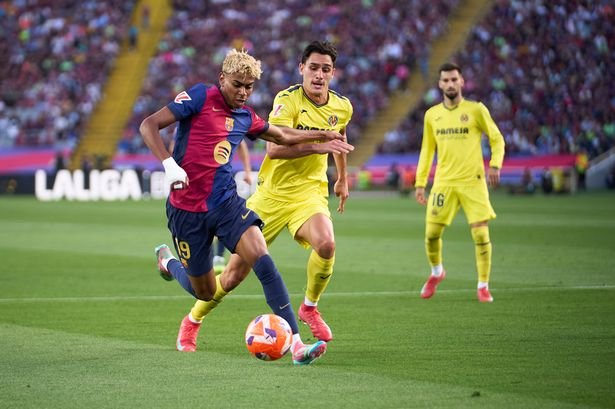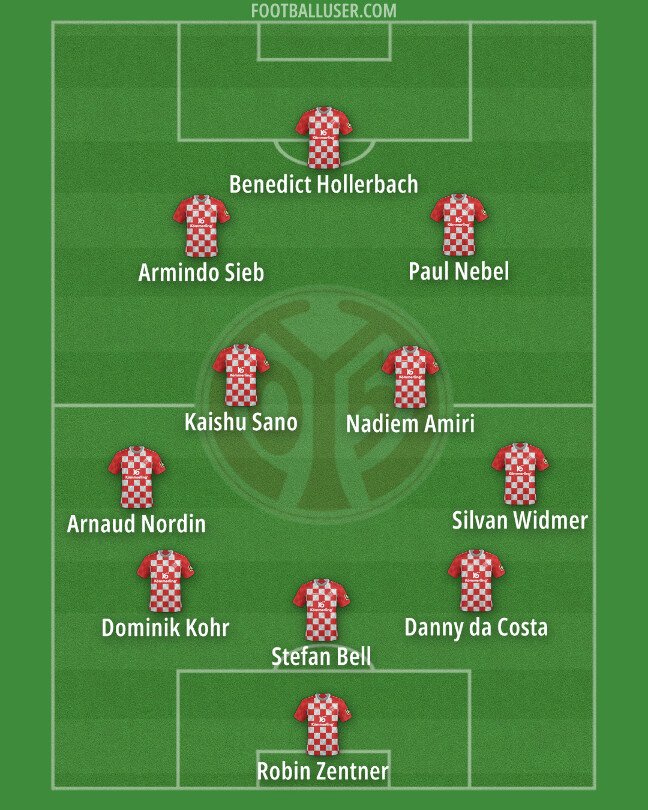The 2025-26 season has already begun, but it is not yet clear where Barcelona are going to play their home matches.
Barca have not played at their Camp Nou ground since starting a €1.5billion (£1.3bn; $1.8bn) refurbishment project in June 2023, hosting games at the Estadi Olimpic Lluis Companys across the city while works progress.
Club president Joan Laporta has repeatedly said that returning to the 105,000-capacity remodelled stadium as soon as possible is crucial to boosting their troubled finances.
The latest target for their return was their La Liga game against Valencia, currently scheduled for September 14 (although the date may be moved across that weekend). The plan was to reopen the Camp Nou at a reduced capacity of about 27,000. That would also make the stadium available for the league phase of the Champions League, which begins a few days later.
However, the project continues to hit delays over factors within and beyond the club’s control, as The Athletic can outline after conversations with multiple sources, who all requested anonymity as they were not authorised to speak publicly.
When were Barca supposed to be back?
When Barca partnered with Turkish builders Limak in January 2023, Laporta said they were the only bidding company that committed to the team being able to return (at two-thirds of capacity) for Barca’s 125th anniversary in November 2024, and completing the project in full before June 2026.
That projected timeline quickly began to look very ambitious as all the original architects, engineers and consultants from Josep Maria Bartomeu’s time left the project, including the original Japanese architects Nikken Sekkei.
Many of the new executives and partners hired lacked experience with such complex projects. Limak’s only previous sports stadium was the 25,000-seater Mersin Arena in southern Turkey.
Hurdles have included problems obtaining required permits from the city council, complaints from residents about noise and light pollution, reports of workers’ rights not being respected by local authorities, and suppliers going bankrupt. Russia’s invasion of Ukraine affected the cost and availability of materials.

Barcelona’s Camp Nou under construction, pictured on August 20 (Xavier Bonilla/NurPhoto via Getty Images)
Barcelona played the entire 2023-24 season at the Estadi Olimpic Lluis Companys on Montjuic, about 4km from the Camp Nou, a ground that has around 40,000 fewer seats than the old Camp Nou.
In July 2024, Barca vice-president Elena Fort said the Camp Nou would be “ready for play by the end of the year”. In September, two months from the intended return date, Laporta said the club “didn’t want to set dates” because “it might happen later or it might even happen earlier”. An October club statement said the team was expected to return to the Camp Nou “in the second half” of the 2024-2025 campaign. Fort told Catalan radio station RAC1 in January 2025: “We will return before the end of this season.”
That also proved impossible, and Barca had to apply to the local authorities to allow them to finish the 2024-25 campaign in the Lluis Companys. Major embarrassment was narrowly avoided when a Rolling Stones concert scheduled to be held at the stadium on the same weekend as May’s La Liga Clasico against Real Madrid was cancelled by the old rockers.
How have things progressed this summer?
At the start of the summer, Barca targeted their traditional season-opening friendly match, the Joan Gamper Trophy on August 10, as their first game back at the Camp Nou.
However, the club did not even get to the stage of formally applying to the city council for the required permits. Italian side Como were instead received at the Estadi Johan Cruyff at the club’s training ground, a 6,000-capacity facility used by Barcelona’s women’s team and the men’s reserve side.

Work started on Barca’s new stadium in June 2023 (Xavier Bonilla/NurPhoto via Getty Images)
Still, The Athletic reported in early August that the club was not considering a Plan B. The club hierarchy remained confident they could play all this season’s competitive games at the Camp Nou, albeit beginning with a reduced attendance of around 27,000 fans.
How is that confidence looking now?
Some important progress has been made — Barca released a video on August 13 showing progress in the internal public areas of the stadium, the playing surface installed, and seating in place in the Gol Sud (south goal) and Tribuna (down one side of the pitch) stands. However, the images also showed how much work remains.
Culers, come with us to the Spotify Camp Nou! 🏟️👀 pic.twitter.com/mzEMdsS1FS
— FC Barcelona (@FCBarcelona) August 13, 2025
To gain official permission for fans to be allowed into the stadium, a ‘certificado de final de obra’ (CFO, certificate of work completion) must be signed by the club and its partners in the project. The local town hall then reviews the document and decides whether to grant a ‘licencia de primera ocupacion’ (LPO, first occupancy license) to allow a certain number of supporters to attend.
Barcelona’s deputy mayor, Albert Batlle, told local radio station RAC1 on Thursday that “no CFO has been presented, so as things stand, an LPO cannot be requested”. Batlle added that “the focus should not be on the timeframe, but on ensuring everyone’s safety”.
What has been La Liga’s stance?
La Liga allowed Barca to play their first three domestic league matches away from home — last Saturday’s 3-0 win at Mallorca, Saturday’s visit to Levante, and the game at Rayo Vallecano on August 31. Their first home game is therefore currently scheduled against Valencia on September 14 (in La Liga, match dates tend to be fully confirmed closer to the time).
Such flexibility on La Liga’s part is not uncommon — for example, Real Madrid were allowed to play their first three games of 2023-24 on the road when their renovated Bernabeu was being readied.
The Athletic can confirm that inspectors from La Liga’s stadium supervision committee visited the Camp Nou last Tuesday, but no immediate conclusions were shared.
Do Barca have a plan B?
Although Barca have publicly and privately maintained all summer that they would not return to Montjuic, the idea has not gone away. Deputy mayor Batlle suggested to RAC1 on Thursday that this was the most sensible option.
“It’s prudent to begin to think of alternatives,” he said. “Among other things, so there is no hurry. Fortunately, the Estadi Olimpic is there as a substitute.”

A projection of the future Camp Nou (FC Barcelona)
A wrinkle in that plan is a concert by American rapper and singer Post Malone at the venue on Friday, September 12, making it impossible for Valencia to be hosted there a few days later.
Flick’s team could, in theory, play Valencia behind closed doors at the Camp Nou if they get that type of a license from the town hall. But the Estadi Johan Cruyff at their training ground does not meet La Liga’s requirements for a top-flight stadium, so that is not an option.
Barca could also play at another ground that does have La Liga standards (such as a VAR setup and broadcast positions). Renting their city rival Espanyol’s 40,500-seater RCDE Stadium is difficult to imagine, with Girona’s 14,600-capacity Montilivi the next closest geographically.
After the Valencia game, Barca’s next home La Liga fixture is against Getafe on the weekend of September 20/21. Montjuic would, in theory, be available then, and there are no more concerts scheduled there until May 2026.
Barca were approached for comment but said they would speak to their socios (club members) and fans only when “full information” was available.
What about UEFA’s view?
Sources say Barca have indicated to UEFA their intention to play all their 2025-26 Champions League games at the Camp Nou.
On Thursday, UEFA staff visited the stadium to gather information to make a final call on whether it would be up to the standards required to host a Champions League game when the league phase starts on September 16-18.
Barca could ask UEFA to tweak the fixtures so they would not have a home game until gameweek two (September 30/October 1). On Thursday, Catalunya Radio reported that UEFA had agreed to this.
UEFA has strict rules regarding facilities for spectators, including five per cent of seats being made available for away fans. The governing body also requires safe and secure camera positions in all four stands, as well as wheelchair-user spaces and hospitality areas for VIP guests.
Sources say a UEFA decision on the Camp Nou’s suitability should be expected quickly, given that the draw for the league phase of the Champions League takes place next Thursday. If UEFA rules it out, Barca would have to propose another stadium, with Montjuic again the most likely option.
UEFA regulation 25.08 says that, from the league phase on, a club must “in principle” play all its matches in the competition at the same stadium. This allows UEFA wiggle-room, but any changes would most likely come between the league phase and knockouts beginning in February 2026.
How much is this costing Barca? And has it affected transfers?
Barca figures, including Laporta, have always been clear that the stadium financing would not affect the club’s capacity to sign or register players.
Repayments do not begin until the new stadium is already generating increased revenues. La Liga’s salary cap rules also make allowances for teams investing in stadium infrastructure.
But in 2023, the club estimated that playing one season at Montjuic would cost them about €90m in lost revenues. They have so far played two. A total sum of €180m would be a conservative estimate given the at times disappointing attendances at their temporary home.

Laporta at the Joan Gamper, which had to be moved to the Estadi Johan Cruyff (Eric Alonso/Getty Images)
The longer the team are away from the Camp Nou, the bigger the financial hit. Barca have not yet made any tickets for their 2025-26 games available for purchase. Season ticket sales usually begin in early June, but have still not started, with the campaign already underway.
Meanwhile, Barca remain above their permitted La Liga salary limit. The club had hoped that raising €100m by selling future VIP box revenue at the new stadium would help resolve that issue. Club sources told The Athletic in early July that Limak were focused on building all of those VIP seats before the end of summer. Catalan outlet Ara has claimed that this has caused further delays with the construction project. La Liga has yet to receive information on this €100m, so it cannot yet be used to help with their budget for 2025-26.
Instead, creative means were required to register this summer’s biggest signings, Joan Garcia (taking advantage of club captain Marc-Andre ter Stegen’s injury) and Marcus Rashford (a €7m guarantee from club directors).
What’s the history of the project?
Barca have long planned to renovate the Camp Nou, which first opened in 1957.
During his first presidency in 2006, Laporta hired English architect Norman Foster to work on a redesign, but that project never materialised. In April 2014, during Bartomeu’s presidency, club socio members approved a new Espai Barca modernisation of the old Camp Nou and its surroundings.
The club then hit deep financial problems, exacerbated by the Covid-19 pandemic, but when Bartomeu left in autumn 2020, an €815m project was almost ready to go. Laporta replaced that with a more expansive and expensive plan, including a double ring of VIP boxes to generate much more matchday income.
Bartomeu’s project allowed for the team to continue to play at the stadium during construction, but Laporta’s more technically complex plan required a move to the Lluis Companys across the city.
(Top photo: Xavier Bonilla/NurPhoto via Getty Images)







